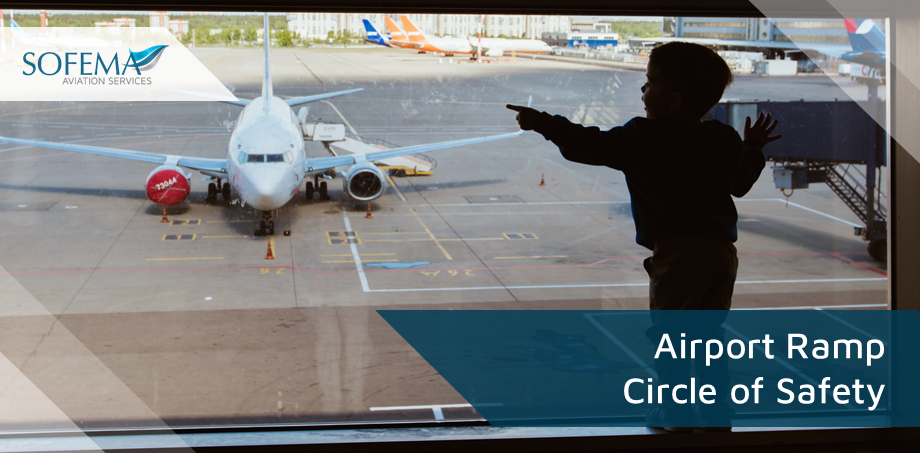Sofema Aviation Services (SAS) www.sassofia.com considers best practice ramp operations – Circle of Safety.
Introduction – What is the Circle of Safety?
The Aerodrome Ramp Circle of Safety refers to a designated area around an aircraft, especially when it’s parked or being serviced on the ramp (also known as the apron or tarmac). This area is established to ensure the safety of both the aircraft and ground personnel.
The Circle of Safety is a concept accepted worldwide to minimize damage to equipment caused by ground equipment. This concept involves two imaginary lines around the aircraft, 1st line at 10 meters and the second line at 2 meters.
Circle of Safety Purpose:
- To prevent damage to the aircraft from ground vehicles, equipment, or personnel inadvertently coming into contact with it.
- To ensure that ground crew, passengers, and other personnel are safe from potential hazards like moving aircraft parts (e.g., propellers or jet engines).
Circle of Safety Required Behaviour
Before approaching the Aircraft YOU MUST
- Be aware of Jet intake and exhaust danger zones. Jet blast is powerful enough to overturn vehicles. The engine intake when powered up is strong enough to suck in a fully grown person.
- Under No Circumstances approach any aircraft whilst the anti-collision beacon is flashing.
- Ensure the aircraft’s anti-collision lights are off, engines shut down, chocks inserted by the engineer and a clear thumbs up given before equipment or personnel approach the aircraft.
- Always wait for the engineer to provide a thumbs-up before approaching the aircraft.
Circle of Safety General Rules
- Respect the Boundary: Always be aware of the circle of safety’s boundaries and avoid crossing them unless it’s necessary for your specific task.
- Clear Communication: If you need to enter the circle, communicate your intentions with other ground crew members or the aircraft’s crew.
- Use Safety Gear: Depending on the airport’s regulations and the specific task, use the appropriate safety gear (e.g., high-visibility vests, ear protection) when inside the circle.
- Stay Alert: Always be aware of your surroundings. Look out for moving aircraft parts and other potential hazards.
- Follow Procedures: Adhere to established procedures for tasks like refuelling, maintenance, or boarding to ensure safety.
Approaching the Aircraft
- All vehicles approaching the aircraft must: Test brakes at the 10-meter line
- Proceed at 5 kph Come to a complete stop at the 2-meter line,
- Approach at a crawling pace in low gear
- If approaching the Aircraft Door or Cargo Compartment Door – then a marshaller should be providing specific support and guidance.
- Never under any circumstances drive vehicles or equipment underneath the fuselage
- Do not drive between the engines on wide bodied aircraft.
- Equipment must not be parked underneath wing tip of aircraft due to fuel spillage and possible fire hazard.
- Beware of slide deployment zones while working around aircraft.
General Awareness – Be aware of the following:
- Emergency evacuation areas
- Aircraft fuel spillage zone (potential fire hazard).
Circle of Safety Awareness Training:
Ground crew and other airport personnel should be trained to recognize and respect the circle of safety. This includes understanding the risks associated with entering the area without a valid reason and the potential dangers posed by aircraft components.
- When tasks need to be performed within the circle of safety, such as refueling, baggage handling, or maintenance, there should be clear communication and coordination among all involved parties.
Next Steps
Follow this link to our Library to find & download related documents for Free.
Please see the following training course Aircraft Servicing, Cleaning, and Detailing – 2 Days
For questions or comments please email team@sassofia.com
Tags:
Aerodrome, Aircraft components, Aircraft Ramp, Aircraft Servicing, airport personnel, Airport Ramp Safety, Airport Safety, apron, baggage handling, Cargo Compartment Door, Circle of safety, danger zones, fuselage, ground personnel, grown person, jet engines, potential hazards, propellers, refuelling, Safety Awareness Training, safety gear, SAS blogs, SAS Library, slide deployment zones, tarmac




